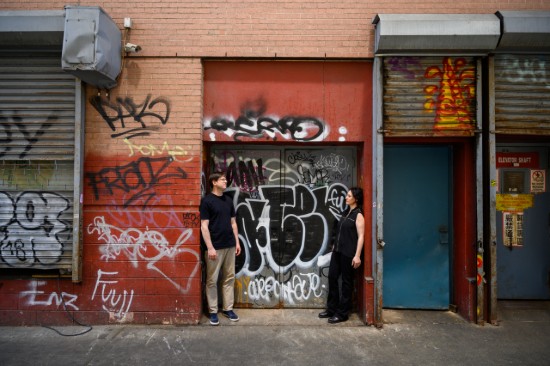
What happens when two supremely talented musicians collaborate on a new recording, and then throw some poetry into the mix? That’s the case with Broken Fall, the new album from Kid Millions and Sarah Bernstein. Millions demonstrates his fondness for frenetic rhythms, while Bernstein summons up fantastically atmospheric sounds with her violin and voice, creating a haunting and unpredictable sound from beginning to end. I talked with both musicians about the process of making this one, how it relates to their prior work, and how they got some of the album’s most distinctive sounds to emerge.
This is your second time collaborating on an album. What were your goals for this relative to Tense Life?
Kid Millions: It’s our third release – we did one live cassette before Tense Life. We had a more distilled approach and target feel for this one. It’s improvisation in a way – but it’s actually more thematic. We know the contours of what we’re doing right now – so we just had to find that when we were in the studio. We wanted this album to stand out from other improvisation records – which can be somewhat uniform – not necessarily in actual results – but as genre exercises. We wanted this one to step outside of those expectations. We got there by establishing what we were trying to make; something monolithic.
Sarah, the violin sound on this album is as gloriously cacophonous as anything I’ve heard coming from a guitar; how did you get that sound?
Sarah Bernstein: I’ve been working with electronic processing of the violin for a long while, and I’ve been drawn to different sounds depending on the project or music. More recently my improvisational approach to effects has taken a turn towards the very loud, or sheer noise. I don’t mind if it sounds like a guitar, or a machine, or anything else with no resemblance to a violin. The violin is just the vehicle for me, and it is a good one, a versatile one. More specifically, I use multiple distortions, multiple reverb/delays, octave below, octave up, etc. The violin I’m playing is an acoustic instrument with an electronic pick-up. I play it through a relatively small amp, and then run that amp through other amps or a PA.
You’ve incorporated poetry lyrically throughout the album. When did you decide to add that element to these songs, and how did it relate to your improvisational approach?
SB: The decision to abstractly add lyrics instead of just wordless vocals came when we were beginning to play longer sets. Our early performances were pretty short, hit hard, play loud, done. But when I thought about how to extend the experience to around 45 minutes, I felt like I could create more of a build by incorporating text. It helps me click into different moments, and I think it does the same for the listeners. What I ended up with is a hybrid between something like lead singing and free noise/expression.
What was the experience of making this album like, compared with one of your live performances?
KM: I don’t really differentiate between the experiences so much…it costs less for us to perform live.
SB: Yeah, in the recording studio we just start playing and see what happens, same as live.
You’ve both worked extensively with a host of musical ensembles. What do you feel sets this collaboration apart from your other work?
KM: I knew that we were a good match from the first show we played…I found that I surprised myself with my choices when I was playing with Sarah – so that was exciting. It’s another facet of what I do – but a really satisfying one. I think we have a special musical bond. We make unusual music and it brings out the best in my playing – so of course that’s something I’m happy to pursue.
SB: We do have a surprising and unique connection. It doesn’t remind me of any other musician or ensemble I play with. Not just because of the style or content, but the feeling is also very different, like we enter some other world for the length of the set and then crash back to earth right after.
Photo: Caleb Bryant Miller
Follow Vol. 1 Brooklyn on Twitter, Facebook, and sign up for our mailing list.
